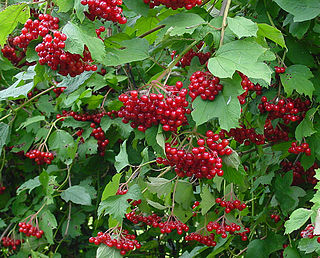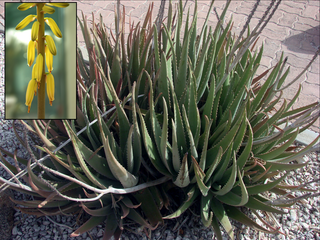
Spearmint, a species of mint (mentha) scientifically classified as Mentha spicata (,) also known as garden mint, common mint, lamb mint and mackerel mint, is native to Europe and southern temperate Asia, extending from Ireland in the west to southern China in the east. It is naturalized in many other temperate parts of the world, including northern and southern Africa, North America, and South America. It is used as a flavouring in food and herbal teas. The aromatic oil, called oil of spearmint, is also used as a flavoring and sometimes as a scent.

Viburnum is a genus of about 150–175 species of flowering plants in the moschatel family, Adoxaceae. Its current classification is based on molecular phylogeny. It was previously included in the honeysuckle family Caprifoliaceae.

Koelreuteria paniculata is a species of flowering plant in the family Sapindaceae, native to China. Naturalized in Korea and Japan since at least the 1200s, it was introduced in Europe in 1747, and to America in 1763, and has become a popular landscape tree worldwide. Common names include goldenrain tree, pride of India, China tree, and the varnish tree.

Aloe vera is a succulent plant species of the genus Aloe. It is widely distributed, and is considered an invasive species in many world regions.

Zanthoxylum is a genus of about 250 species of deciduous and evergreen trees, shrubs and climbers in the family Rutaceae that are native to warm temperate and subtropical areas worldwide. It is the type genus of the tribe Zanthoxyleae in the subfamily Rutoideae. Several of the species have yellow heartwood, to which their generic name alludes. Several species are cultivated for their use as spices, notably including Sichuan pepper.

Zanthoxylum simulans, the Chinese-pepper, Chinese prickly-ash or flatspine prickly-ash, is a flowering plant in the family Rutaceae, native to eastern China and Taiwan. It is one of several species of Zanthoxylum from which Sichuan pepper is produced.

Perilla frutescens, also called deulkkae or Korean perilla, is a species of Perilla in the mint family Lamiaceae. It is an annual plant native to Southeast Asia and Indian highlands, and is traditionally grown in the Korean peninsula, southern China, Japan and India as a crop.

Mentha canadensis is a species of mint native to North America and the eastern part of Asia. In North America, it is commonly known as Canada mint, American wild mint, and in Asia as Chinese mint, Sakhalin mint, Japanese mint, and East Asian wild mint. The flowers are bluish or have a slight violet tint. The plant is upright, growing to about 4–18 in (10–46 cm) tall. Leaves grow opposite from each other, and flower bunches appear in the upper leaf axils. The mint grows in wet areas but not directly in water, so it will be found near sloughs, and lake and river edges. Plants bloom from July to August in their native habitats.

"Uzazi" is the Nigerian name for the 'prickly ash' tree of genus Zanthoxylum tessmannii / Fagara tessmannii / Zanthoxylum gilletii, a member of the Rutaceae family, native to Central and West Africa, and a close relative of the Sichuan pepper. It usually refers specifically to the spice made from its fruit and pericarp, though sometimes other parts of it such as its leaves are used.

Malus sieboldii, commonly called Siebold's crab, Siebold's crabapple or Toringo crabapple, is a species of crabapple in the family Rosaceae.

Pestalotiopsis is a genus of ascomycete fungi in the Sporocadaceae family.

Zanthoxylum armatum, also called winged prickly ash or rattan pepper in English, is a species of plant in the family Rutaceae. It is an aromatic, deciduous, spiny shrub growing to 3.5 metres (11 ft) in height, endemic from Pakistan across to Southeast Asia and up to Korea and Japan. It is one of the sources of the spice Sichuan pepper, and also used in folk medicine, essential oil production and as an ornamental garden plant.

Zanthoxylum piperitum, also known as Japanese pepper or Japanese prickly-ash is a deciduous aromatic spiny shrub or small tree of the citrus and rue family Rutaceae, native to Japan and Korea.

Zanthoxylum acanthopodium, or andaliman, is a species of flowering plant in the family Rutaceae. Its range includes southern western China, Bangladesh, Bhutan, northern India and northeastern India, Nepal, Laos, Burma, northern Thailand, Vietnam, Indonesia, and Peninsular Malaysia.

Sichuan pepper, also known as Szechuan pepper, Szechwan pepper, Chinese prickly ash, Chinese pepper, Mountain pepper, and mala pepper, is a spice commonly used in Sichuan cuisine in China, in Nepal, and in northeast India. Despite its name, Sichuan pepper is not closely related to black pepper or chili peppers. It is made from plants of the genus Zanthoxylum in the family Rutaceae, which includes citrus and rue.
Zanthoxylum austrosinense, or South Chinese Sichuan pepper, is a woody plant in the family Rutaceae and is native to southern China.
Zanthoxylum dissitum is a woody plant native to China. It grows in upland thickets and open forests, forests, at 300-2600 m altitude.
Zanthoxylum echinocarpum is a woody plant in the family Rutaceae and is native to South-Central and Southeast China.

The Sporocadaceae are a family of fungi, that was formerly in the order Xylariales. It was placed in the Amphisphaeriales order in 2020.
Pseudopestalotiopsis is a genus of plant pathogens in the family Sporocadaceae.
















